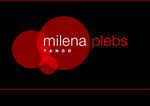
El reciente Festival Cambalache reaviva la reflexión sobre cómo fusionar el tango con la danza y el teatro. Intuyo que la propuesta de búsqueda va dirigida a la expresión teatral y danzada más que al ballet y al show.Como otro cambalache, me surgen algunas ideas para debatir, probar y quizás, rebatir.
Foto: Ezequiel Farfaro/Gilda Stillback por Per Englund
See english translation below
Las variables posibles a la hora de la creación son infinitas. Sin embargo, el tango bailado tiene ciertas características que sería bueno considerar: La pareja abrazada. Cuando un hombre y una mujer se toman para bailar tango se despliega una serie de símbolos arquetípicos propios de esa situación: encuentro, atracción, seducción, celebración, etcétera. Esto ocurre sin que nadie se lo proponga porque está culturalmente arraigado. Si la intención de la escena es otra, es muy importante trabajar en resignificar ese abrazo, sino el tango inevitablemente nos llevará a esas expresiones. Unísono: O sea, varias parejas o personas haciendo lo mismo. Esto es algo que funciona y vemos usualmente en ballets o shows. Si en un espectáculo de teatro o danza, en medio de una escena con contenido dramático, se ponen a bailar al unísono, me pregunto por qué. ¿Qué están expresando? ¿Cuál es el sentido? Hay casos en donde pueden estar representando cierta uniformidad grupal: danzas cortesanas, desfiles, danzas tribales o circulares, descripción de formas geométricas u otros ejemplos justificados. Pero si no, creo que es un recurso a revisar, amén de que sólo se soporta si hay perfecta sincronía. Acción y reacción: El tango ofrece una gran riqueza de movimientos: dos personas unidas por un enlace o abrazo, una de ellas promueve una acción a la otra, ésta reacciona con otro movimiento mediante un código aprendido y así se van encadenando las secuencias. El desafío es buscar nuevas posibilidades de esta mecánica. Otra variante es incorporar la improvisación de tango en la escena, no como “relleno” sino como elemento principal, cosa no fácil de resolver pero que puede aportar dinámicas de expresión interesantes. En el III Festival Cambalache se vieron propuestas muy enriquecedoras. No es mi intención criticar sino poner en palabras algunas ideas para continuar con la búsqueda. Queda mucho para seguir hablando. Definitivamente el tango se ha transformado en un nuevo lenguaje dentro del espectro de las expresiones artísticas existentes.
Copyright © El Tangauta 2007
------------------------------------------------------
Tango+dance+theatre - The recent Festival Cambalache reawakens reflection on how to fuse tango with dance and theater. I sense that the search is directed to theatrical and dance expression more than to ballet and shows. Some ideas come to my mind to debate, to test and perhaps, to refute. The possible variables at the moment of creation are infinite. Nevertheless, tango as a dance has certain characteristics that it would be good to consider: The embraced couple. When a man and a woman dance tango a series of symbolic archetypes of that situation unfold: encounter, attraction, seduction, celebration, etc. This occurs without anybody explicitly proposing it because it is culturally established. If the intention of the scene is different, it is very important to work on giving its new meaning to that embrace, otherwise tango inevitably will take us to those expressions. Unison. We mean several couples or people doing the same thing. This is something that works well and we see usually in ballets or shows. If in a theater or dance show, in the middle of a scene with dramatic content, the performers begin to dance in unison, I ask myself why. What are they expressing? In what sense? There are occasions that may require certain group uniformity: courtesan dances, parades, tribal or circular dances, description of geometric forms or other justified examples. But if this is not the case, I believe that it is a resource to use with great care, not to mention that it can only be tolerated if there is perfect synchrony. Action and reaction. Tango offers a great wealth of movements: two people united by an embrace, one of them promotes an action of the other, who reacts with another movement by means of a learned code and thus they chain the sequences. The challenge is to seek new possibilities for this mechanism. Another variation is to incorporate tango improvisation in the scene, not as “filling” but as a main element, not an easy thing to work out but one that can contribute interesting dynamics of expression. In the III Festival Cambalache we saw very enriching proposals. It is not my intention to criticize but to put in words some ideas to continue with the search.There is still a lot to talk about. Definitely tango has turned into a new language within the spectrum of existing artistic expressions.
Copyright © El Tangauta 2007
Copyright © El Tangauta 2007
Publicado en El Tangauta - EDICION nro 147
Traducción: Dolores Longo.






No hay comentarios:
Publicar un comentario